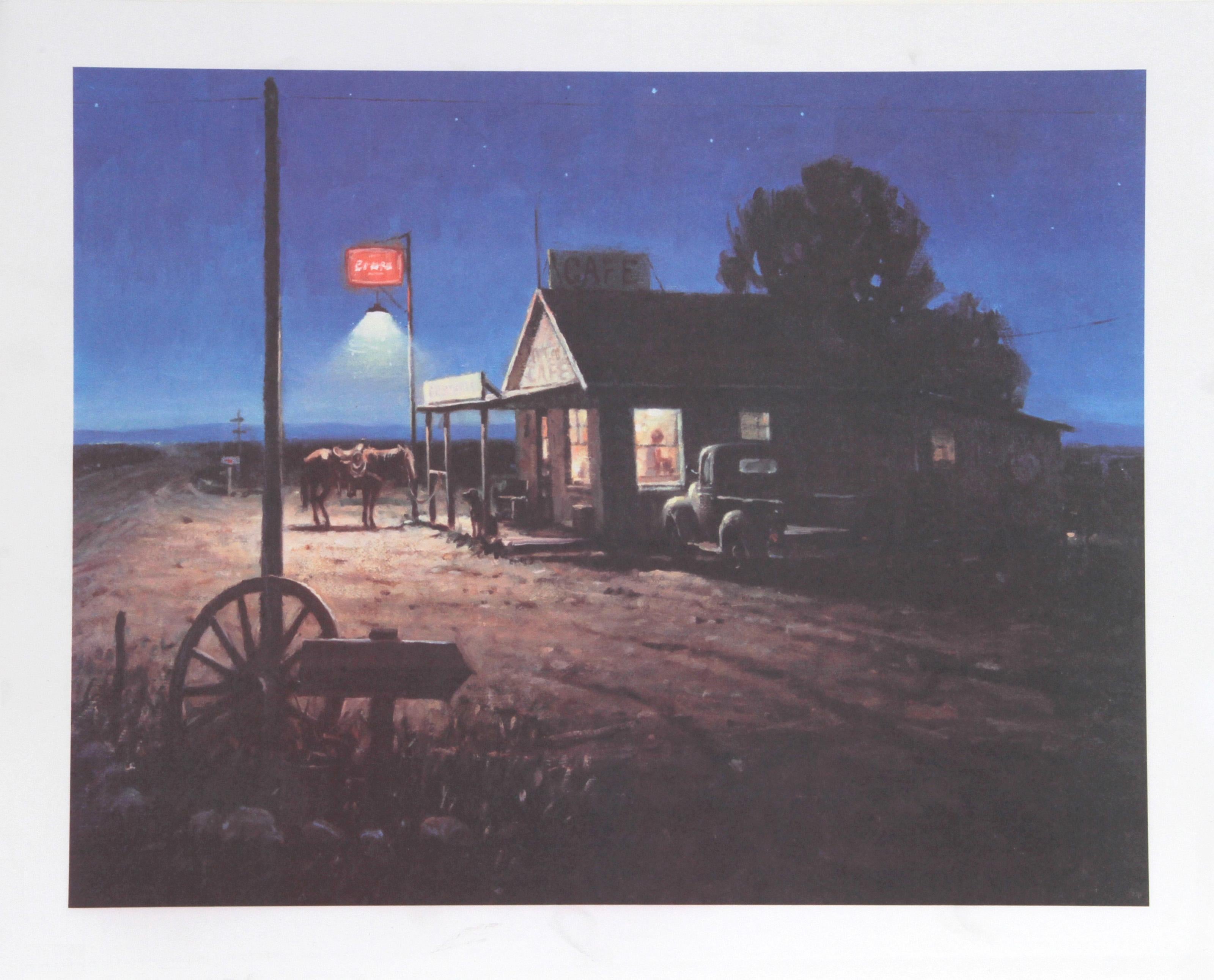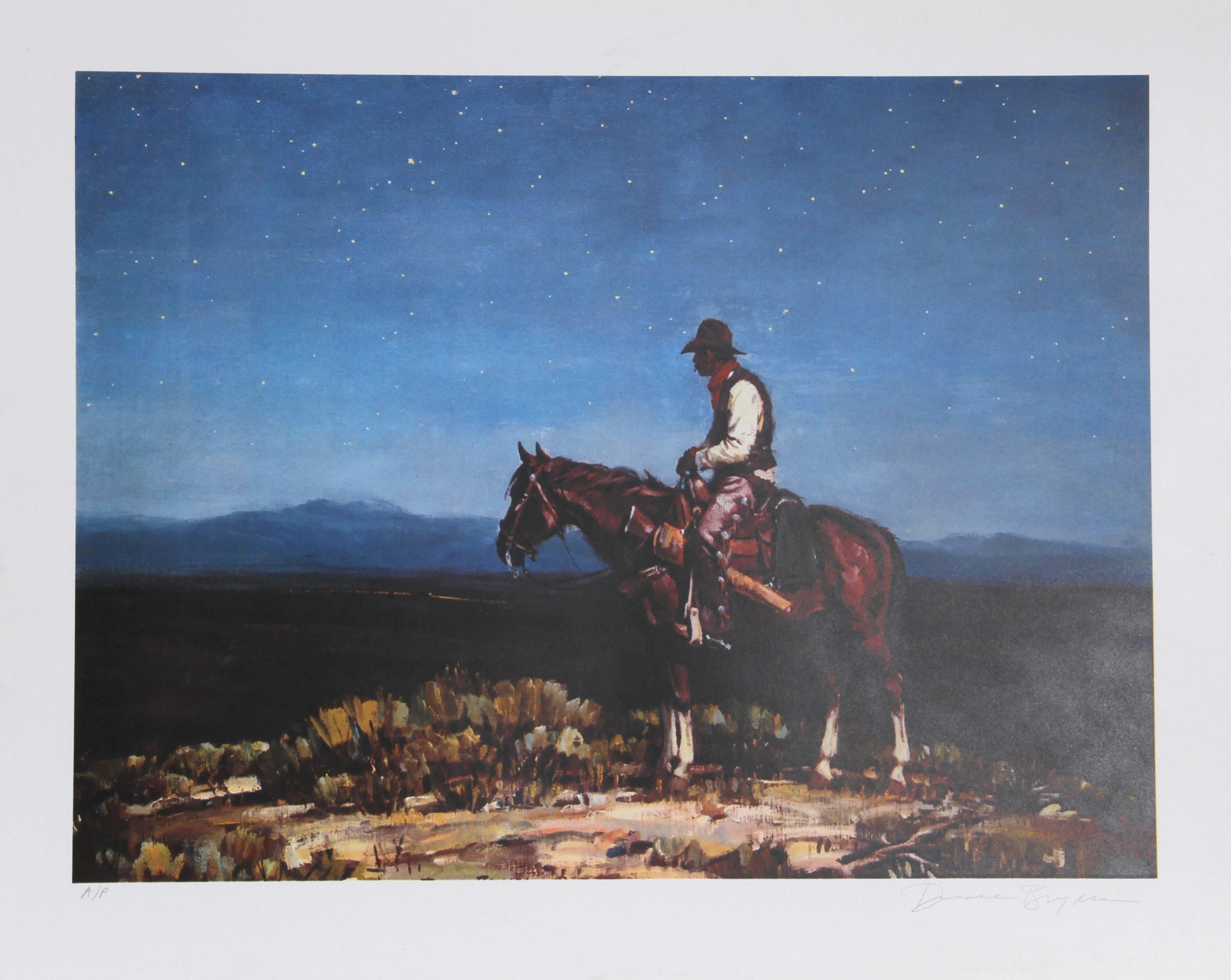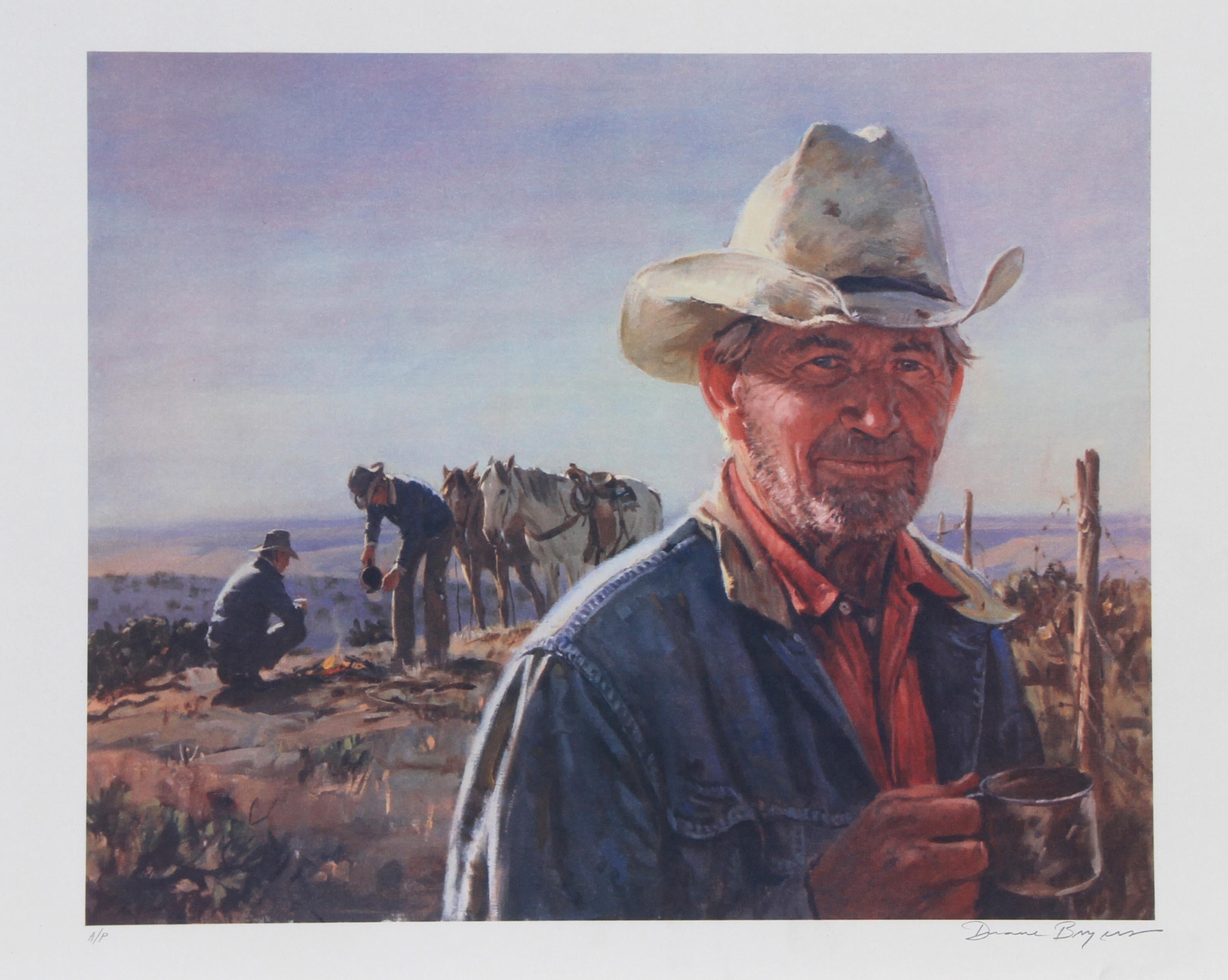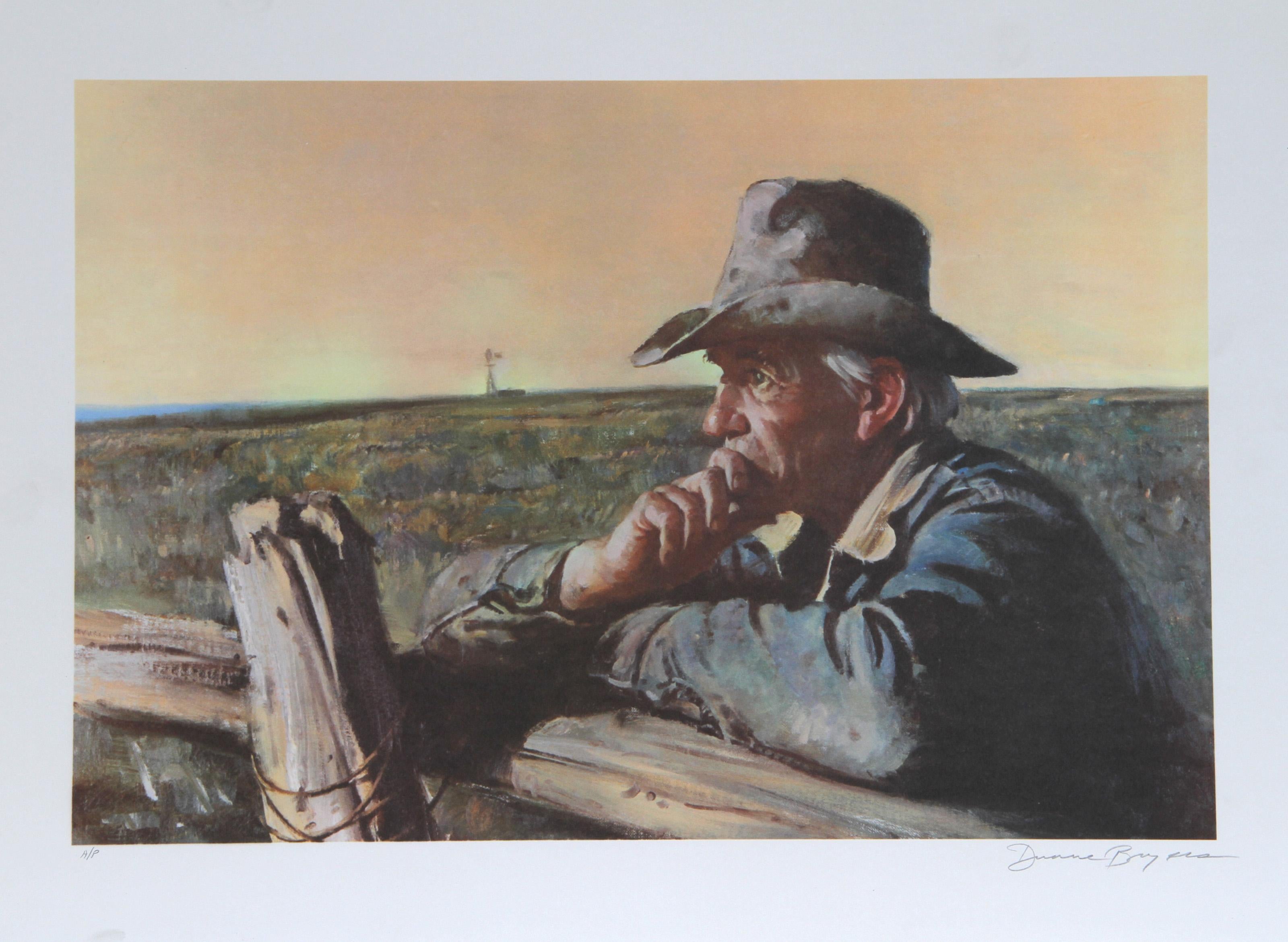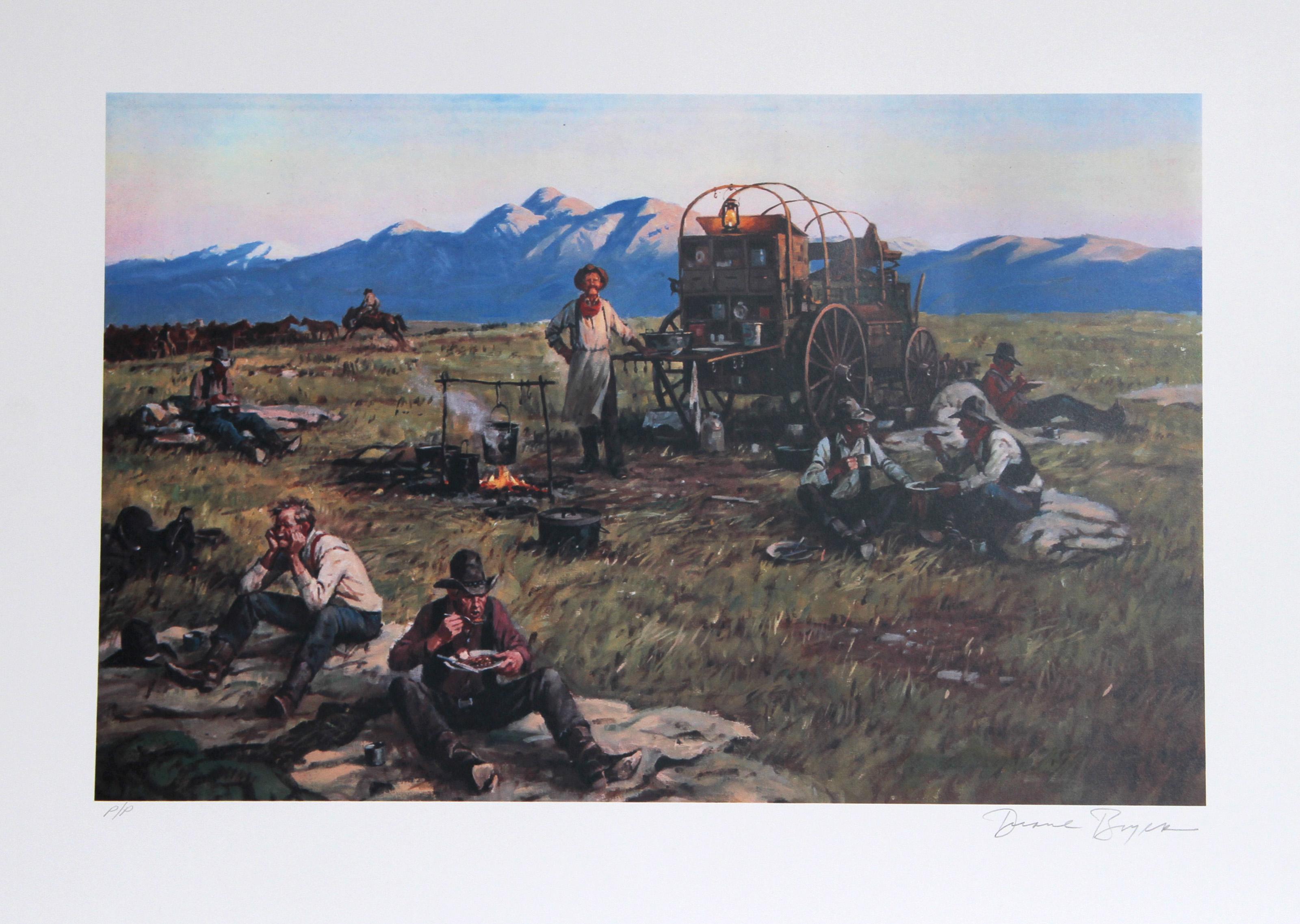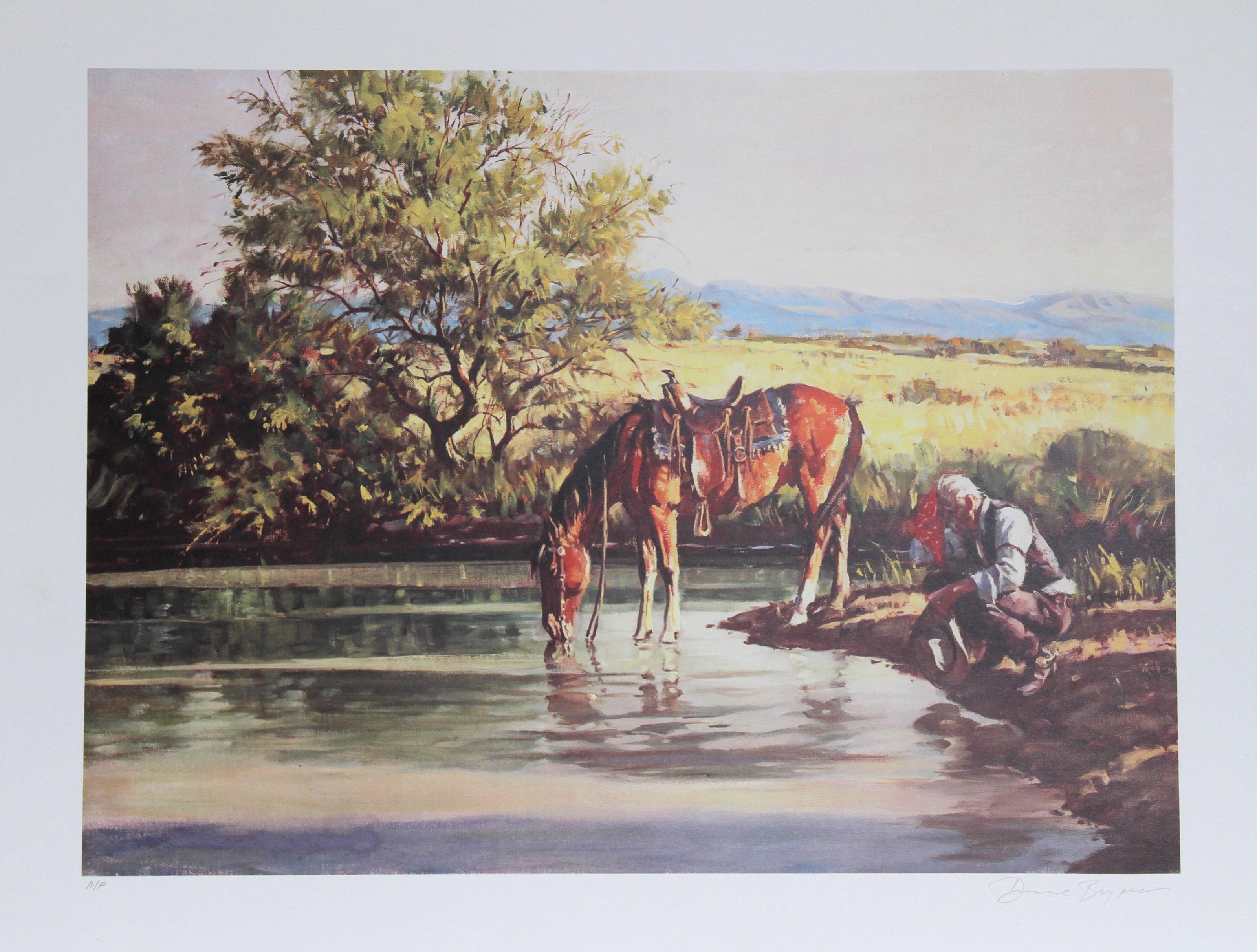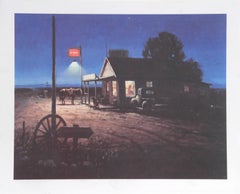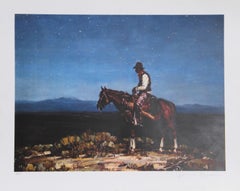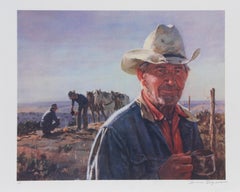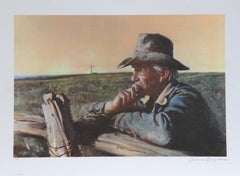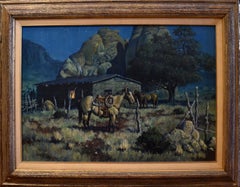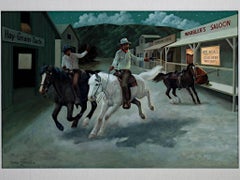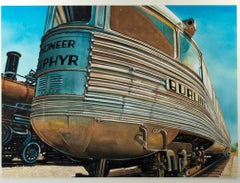Items Similar to Horseshoe Cafe, American Western Art Lithograph by Duane Bryers
Want more images or videos?
Request additional images or videos from the seller
1 of 5
Duane BryersHorseshoe Cafe, American Western Art Lithograph by Duane Bryers1980
1980
$450
£341.22
€391.49
CA$640.29
A$694.58
CHF 365.25
MX$8,451.58
NOK 4,566.17
SEK 4,306.46
DKK 2,922.98
About the Item
Duane Bryers, American (1911 - 2012) - Horseshoe Cafe, Year: 1980, Medium: Lithograph, signed and numbered in pencil, Edition: 300, AP, Size: 21 in. x 28 in. (53.34 cm x 71.12 cm), Description: Lit by a greenish-yellow streetlight, the cafe depicted by Duane Bryers evokes a sense of nostalgia toward the lifestyle of cowboys and the like in the American West. With warm yellow light leaking out through the windows and illuminating the porch and ground outside, the cafe seems like an inviting refuge amid acres of fields.
- Creator:Duane Bryers (1911 - 2012, American)
- Creation Year:1980
- Dimensions:Height: 21 in (53.34 cm)Width: 28 in (71.12 cm)
- Medium:
- Movement & Style:
- Period:
- Framing:Framing Options Available
- Condition:
- Gallery Location:Long Island City, NY
- Reference Number:Seller: RO509171stDibs: LU46616001702
About the Seller
4.9
Platinum Seller
Premium sellers with a 4.7+ rating and 24-hour response times
Established in 1979
1stDibs seller since 2014
3,122 sales on 1stDibs
Typical response time: 1 hour
- ShippingRetrieving quote...Shipping from: Long Island City, NY
- Return Policy
Authenticity Guarantee
In the unlikely event there’s an issue with an item’s authenticity, contact us within 1 year for a full refund. DetailsMoney-Back Guarantee
If your item is not as described, is damaged in transit, or does not arrive, contact us within 7 days for a full refund. Details24-Hour Cancellation
You have a 24-hour grace period in which to reconsider your purchase, with no questions asked.Vetted Professional Sellers
Our world-class sellers must adhere to strict standards for service and quality, maintaining the integrity of our listings.Price-Match Guarantee
If you find that a seller listed the same item for a lower price elsewhere, we’ll match it.Trusted Global Delivery
Our best-in-class carrier network provides specialized shipping options worldwide, including custom delivery.More From This Seller
View AllFour Corners Cafe, American Western Art Lithograph by Duane Bryers
By Duane Bryers
Located in Long Island City, NY
Duane Bryers, American (1911 - 2012) - Four Corners Cafe, Year: 1979, Medium: Lithograph, signed and numbered in pencil, Edition: 300, AP, Image Size: 18 x 22.5 in., Size: 20.5 ...
Category
1970s American Realist Landscape Prints
Materials
Lithograph
Lonesome Train Whistle, American Western Art Lithograph by Duane Bryers
By Duane Bryers
Located in Long Island City, NY
Duane Bryers, American (1911 - 2012) - Lonesome Train Whistle, Year: Circa 1979, Medium: Lithograph, signed and numbered in pencil, Edition: 300, AP, Image Size: 17 x 22 in., Siz...
Category
1970s American Realist Landscape Prints
Materials
Lithograph
Middle of Nowhere, American Western Art Lithograph by Duane Bryers
By Duane Bryers
Located in Long Island City, NY
Duane Bryers, American (1911 - 2012) - Middle of Nowhere, Year: 1979, Medium: Lithograph, Signed and Numbered in Pencil, Edition: 300, AP, Image Size: 16 x 23.5 in, Size: 20.5 i...
Category
1970s American Realist Animal Prints
Materials
Lithograph
All The Yesterdays, American Western Art Lithograph by Duane Bryers
By Duane Bryers
Located in Long Island City, NY
Duane Bryers, American (1911 - 2012) - All The Yesterdays, Year: 1979, Medium: Lithograph, signed and numbered in pencil, Edition: 300, AP, Image Size: 16 x 23.5 in., Size: 20.5...
Category
1970s American Realist Landscape Prints
Materials
Lithograph
His Family, American Western Art Lithograph by Duane Bryers
By Duane Bryers
Located in Long Island City, NY
Duane Bryers, American (1911 - 2012) - His Family, Year: 1979, Medium: Lithograph, Signed and Numbered in Pencil, Edition: 300, AP, Image Size: 14.5 x 22.5 in., Size: 21.5 in. ...
Category
1970s American Realist Landscape Prints
Materials
Lithograph
Along the Way, American Western Art Lithograph by Duane Bryers
By Duane Bryers
Located in Long Island City, NY
Duane Bryers, American (1911 - 2012) - Along the Way, Year: 1979, Medium: Lithograph, signed and numbered in pencil, Edition: AP, Image Size: 17 x 22.5 inches, Size: 21.5 in. x ...
Category
1970s American Realist Landscape Prints
Materials
Lithograph
You May Also Like
SHOE SHOP Signed Lithograph, Cowboy Farrier, Horseshoe, White Horse, Western Art
By Conrad Schwiering 1
Located in Union City, NJ
SHOE SHOP by the American Western artist Conrad Schwiering, is a hand drawn limited edition lithograph(not a photo reproduction or digital print) printed using hand lithography techn...
Category
1980s American Realist Animal Prints
Materials
Lithograph
MARTIN GRELLE "Night Stop", WESTERN HORSES SHACK NOCTURNAL 24 x 36 CANVAS
By Martin Grelle
Located in San Antonio, TX
Martin Grelle
(Born 1954)
Clifton Texas Artist
Image Size: 24 x 36
Frame Size: 33 x 45
Medium: Oil on Canvas
1978
"Night Stop" Nocturnal Western painting
Signed lower left
Biography
Martin Grelle (Born 1954)
Martin Grelle, b. 1954, Clifton, Texas, (United States)
Born and raised in Clifton, Texas, Martin Grelle still lives on a small ranch a few miles from town. His studio sits in the picturesque Meridian Creek Valley, surrounded by the oak & cedar-covered hills of Bosque County, just a short distance from his home, but also within a few miles of the family and friends who are so important in his life. He has two sons, Josh & Jordan, who have left home to pursue their own dreams, but who stay in touch frequently. Martin's parents, Ervin & Ella, have both passed from this life, but he still has his brothers, Carl & Marvin, living nearby, as well as his sister, Mary, who lives in Ft. Worth.
Martin began drawing and painting when he was very young, and was fortunate to have James Boren and Melvin Warren, two professional artists and members of the Cowboy Artists of America, move to the area when he was still in high school, and it has had a lasting impact on his direction and career. Mentored by Boren, he had his first one-man show at a local gallery within a year of graduating from high school in 1973. In the nearly 40 years since that time, he has produced some 30 one-man exhibitions, including annual shows in Scottsdale, Arizona since 1989, and has won awards of both regional and national importance at shows around the country.
He was invited into membership with the Cowboy Artists of America in 1995, fulfilling a dream begun in the early 70's when he first met Boren and Warren. That same year he was invited to participate in the first Prix de West Invitational at the National Cowboy and Western Heritage Museum in Oklahoma City. Since that time, he has won the Prix de West Purchase Award, twice (one of only seven artists to do so), the Nona Jean Hulsey Rumsey Buyers' Choice Award, twice, the CA People's Choice Award in 2002, the CA Ray Swanson Award in 2008, the CA Buyers' Choice Award in 2011 and 2012, and the Silver Award for Water Solubles in 2012. He was awarded the Legacy Award by The Briscoe Museum in 2012, for his impact on western art.
Other major invitational exhibitions and sales Martin has participated in include The Masters at the Autry Museum in Los Angeles, and the inaugural Quest for the West at the Eiteljorg Museum in Indianapolis, the Coeur d'Alene Auction, and the Jackson Hole Art Auction. Martin has also been featured in a number of publications throughout his career, including multiple appearances in the following magazines: Art of the West, Western Art Collector, Southwest Art, Western Art and Architecture, Persimmon Hill, American Cowboy, Western Horseman, Informant, Wild West, and True West's magazine's 2011 Best of the West Source Book. He was honored with a retrospective showing of his work, along with fellow CA artist, Herb Mignery, for the Gilcrease Museum's Rendezvous Show 2013.
Martin has a real sense of responsibility to his collectors, which fills his heart every morning when he walks into the studio, believing that what he does is a gift entrusted to him from God, and must not be left unused or taken for granted, but developed and improved upon. His parents and Jim and Mary Ellen Boren, all set that example for him - an example of not only striving to be the best artist he can be, but the best man he can be as well.
Beyond his studio, Martin strives to pass on what others have passed to him. He has given multiple demonstrations around the country, teaches an annual weekend workshop along with his good friend, and fellow CA, Bruce Greene - which they have done for 22 years straight - and mentors other aspiring artists by critiquing their work. He has donated work to a large number of organizations to aid in their progress, including The Bosque Arts Center in Clifton, Texas.
He has twice served on the board of directors for the CA organization and is currently serving as President. He is also involved with The Joe Beeler Foundation, founded by the Cowboy Artists of America to coincide with their mentoring program, which provides scholarship opportunities for artists seeking to improve their skills, and has served as President of the Foundation for the past year as well.
Education
Self-taught; mentored by James Boren
Cowboy Artists of America Museum, Kerrville, TX, Workshop, Harvey Johnson/Melvin Warren, 1983
Bosque Conservatory, Clifton, TX, Workshop, Bettina Steinke...
Category
1970s Impressionist Landscape Paintings
Materials
Oil
"Saloon, " am Oil on Board signed by Charles Damrow
By Charles Damrow
Located in Milwaukee, WI
"Saloon" is an original oil painting on board signed and dated in the lower left by the artist Charles Damrow. It depicts two cowboys on horseback with guns aiming at the saloon as they ride away. There are bullet-holes in the window of the saloon building and the horse tied...
Category
1970s Other Art Style Figurative Paintings
Materials
Oil
"Pioneer Zephyr, " Watercolor Painting signed by Bruce McCombs
By Bruce McCombs
Located in Milwaukee, WI
"Pioneer Zephyr" is an original photorealist watercolor painting by Bruce McCombs. The artist signed the piece lower right. This artwork features a realistic depiction of a bronze train...
Category
2010s Photorealist Drawings and Watercolor Paintings
Materials
Watercolor
Doggie Diner Booths - iconic watercolor
Located in Burlingame, CA
Phone booths at the Doggie Diner- an iconic American original watercolor painting - 24 x 16 inches - by James Torlakson, who is known for his photorealist oil paintings, watercolors and aquatint intaglio etchings. Doggie Diner Booths...
Category
21st Century and Contemporary American Realist Still-life Drawings and W...
Materials
Watercolor, Archival Paper
‘Cowboy, 1968’
By Richard McLean
Located in Rochester Hills, MI
Richard McLean
‘Cowboy, 1968’
Framed 30 x 27 inches
Pencil on paper 27½” x 22½ inches
Richard McLean is one of the most highly regarded American photo-realists. His paintings l...
Category
1960s Photorealist Figurative Drawings and Watercolors
Materials
Archival Paper, Graphite
More Ways To Browse
Horseshoe Art
Lionel Lindsay
Maine Woodcut
Mammoth Ski Poster
Marco Sadeler
Mary Teichman
Monet Etching
Orchard By David Harrison
Oscar De Mejo
Pablo Picasso Original Inc Sketch
Paul Baum
Paul Emile Lecomte Etching
Paul Pedulla
Peter De Pannemaeker
Peter Max Boat
Pierre Maulin
Rene Eugene Lairy
Richard Estes On Sale
